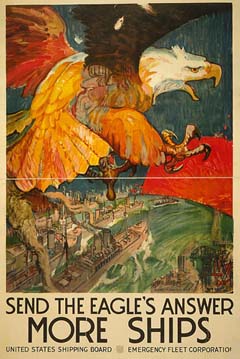Shipbuilding
|
USSB poster - reserve
|
1915 Mar. 4 - La Follette Seamen's Act signed by Wilson March 4 - required 75% crew to understand English orders (to protest native American seamen jobs from Asians, guarenteed payment of half earned wages on demand in American ports (caused British seamen to jump ship for high pay on American ships - $30 per month vs British $20 and $17 Swedish)
1915 May - Thomas Edison declared in a published interview that "the Government should maintain a great research laboratory.... In this could be developed...all the technique of military and naval progression without any vast expense.'' Secretary of the Navy Josephus Daniels appointed Edison as the head of the civilian Naval Consulting Board but the Naval Research Laboratory would not be created until after the war.
1916 Sept. 7 - Shipping Act of 1916 signed by Wilson, created 5-member United States Shipping Board (USSB) to create a subsidiary corporation to build ships.
1917 Jan. - Frederic Eustis idea to mass-produce fleet of cheap small wooden steamers of 3000 tons, rather than larger steel ships of 8000 tons; Frank Sprague supported the Eustis plan (Sprague had pioneered the first electric trolley in Richmond VA 1888); idea supported by USSB chairman William Denman.
1917 Apr. 16 - Emergency Fleet Corp. created, led by George Goethals (promoted to General in 1915 when he finished construction of the Panama Canal, but retired 1916), but nothing done due to Goethals opposition to the wooden ship program sought by the Shipping Board.
1917 Apr. 22 - Foreign Secretary Arthur Balfour mission to U.S., sought more ships than small wooden steamers.
1917 May 2 - Denham endorsed plan for diesel powered motorships, with diesels from Scandinavian company Burmeister and Wain; diesels took less room than steam, allowing for more cargo space.
1917 June 11 - Goethals proposed building fabricated steel ships, but debate on price of steel. Goethals and the EFC proposed to buy steel plate at the high price of 4.25 cents per pound steel plate, giving companies such as Bethlehem Steel a profit of over 50%.
1917 June 15 - Urgent Deficiencies Act of $3 billion included $750 million for shipbuilding.
1917 July 24 - Goethals resigned and became War Dept Quartermaster General where his military style was very successful, and was replaced by Admiral Washington Lee Capps as head of Fleet Corp. Denham forced to resign by Wilson and was replaced by Edward Nash Hurley as head of Shipping Board.
1917 Sept. - Submarine Boat Corp. was built on 112 acres near Newark NJ, with 28 slipways that would make 150 ships during the war, each fabricated ship used 400,000 rivets. The first launched was the Agawam on May 30, 1918.
1917 Oct. - Merchants Shipbuilding Corp. was built near Bristol PA with 12 slipways that would build 60 ships. The workers were provided housing in the new complete town of Harriman, named after company chairman E. Averill Harriman, son of E. H. Harriman.
1918 May - Production of ships rose to 300,000 tons per month by EFC under Director Charles Schwab who moved the EFC from Washington DC to Philadelphia.
1918 May 5 - The New York Shipbuilding Company at Camden NJ built the Tuckahoe in the record time of 27 days, 4 hours, and fitted out the ship in another 10 days.
1918 June 2 - USSB signed contracts with Scofield Engineering Company of Philadelphia to build a concrete shipyard in San Diego. The first two ships were launched in 1920, the Cuyamaca and San Pasqual, and in 1921 the shipyard was transferred to the Navy to become the Fleet Destroyer Repair Base in National City.
1918 June 19 - First ship launched at U. S. Steel shipyard, the cargo ship Liberty, built on 185 acres near Newark, NJ.
1918 July 4 - On a single day, 95 ships were launched from shipyards nationwide, 43 made of steel, 53 of wood. In San Francisco, 17 ships were launched, most from the three shipyards owned by Schwab's Bethlehem Steel Co.
1918 Aug. 8 - First ship launched at Hog Island shipyard, the Quistconck, by Mrs. Woodrow Wilson and the President and an audience of 70,000. By Nov. 1918, Hog Island would produce 180 steel steamers on 50 slipways, the largest number of slips of any shipyard in the nation. Hog Island construction began Sept. 13, 1917, on 900 acres, with the first group of 10 slips working by Apr. 29, 1918, followed by four more groups along 1.5 miles of Delaware river front, and 7 piers each 1000 ft. long along another 1.3 miles, and served by 83 miles of railways. Similar shipyards were built at Newark NJ and Bristol PA by the American International Corporation that had more millionaires on its Board of Directors than any other corporation, that bought controlling interest in W. R. Grace, United Fruit, N.Y. Shipbuilding, and Pacific Mail Steamship Co. (re-opened trans-Pacific service after it had been closed by the 1915 Seamen's Act). AIC hired the Stone and Webster engineering company to build Hog island and other shipyards, and arranged for the production of 20,000 parts that went into every ship from 3,500 companies across the country. Hog Island had a complete hospital, 4 ambulances, and medical staff and full-time dentist, complete restaurants serving full meals for 30 cents to supplement the hoagie sandwiches brought by Italian workers, 600 armed guards and a police station and court, a post office, bank, newspaper, and 45-piece band.
1918 Nov. 11 - By the end of the war, the U. S. built 3000 ships at a cost of $5 billion, in 150 shipyards that employed 300,000 workers.
Links:
Sources:
- "America's Shipbuilding Crusade," The Times History of the War, vol. 18, London, Printing House Square, 1919.
- "Concrete Ships," Literary Digest, Dec. 8, 1917, pp. 26-27.
- Eberhardt, Robert. "Concrete Shipbuilding in San Diego, 1918-1920," Journal of San Diego History 41, Spring 1995, article
